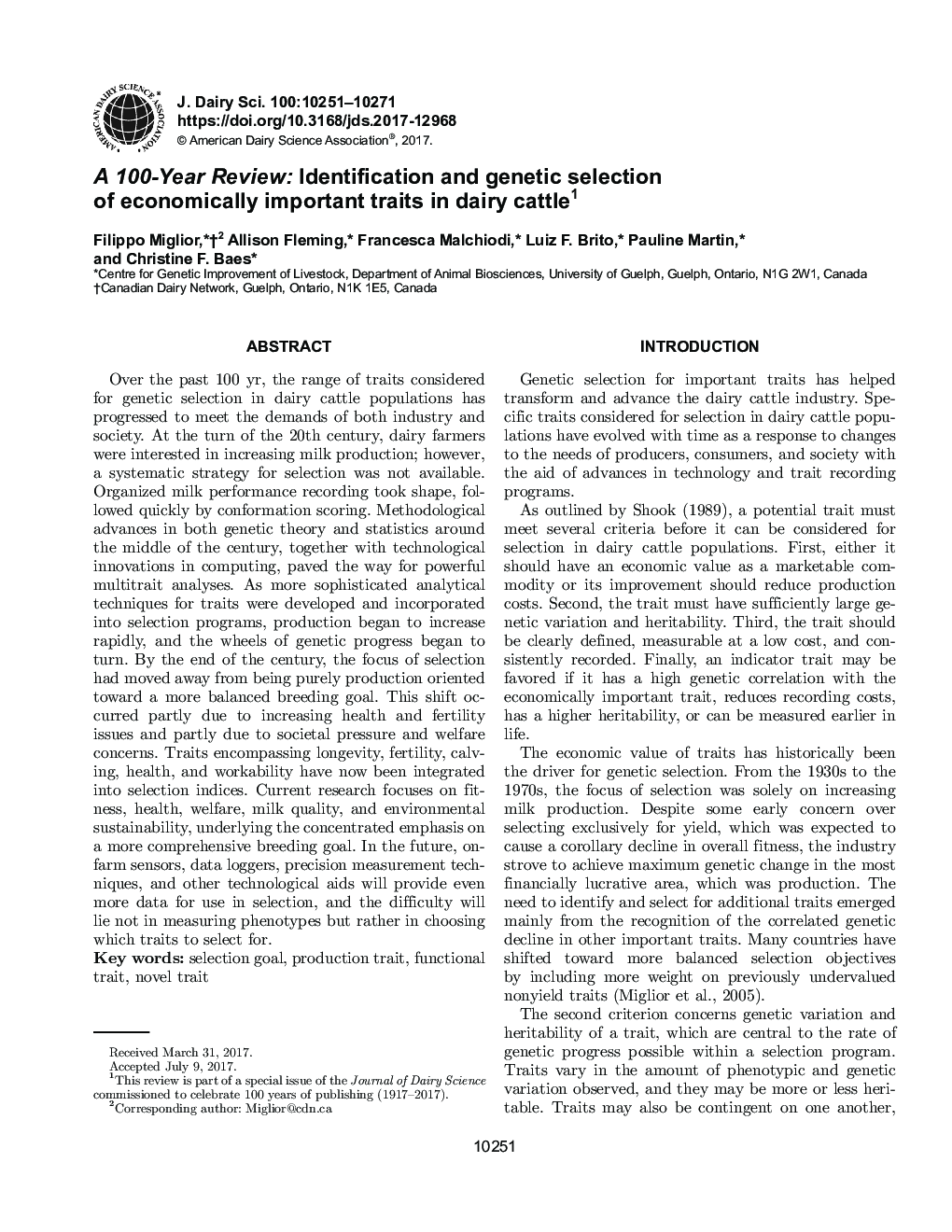| کد مقاله | کد نشریه | سال انتشار | مقاله انگلیسی | نسخه تمام متن |
|---|---|---|---|---|
| 8501805 | 1553845 | 2017 | 21 صفحه PDF | دانلود رایگان |
عنوان انگلیسی مقاله ISI
A 100-Year Review: Identification and genetic selection of economically important traits in dairy cattle
ترجمه فارسی عنوان
یک بررسی 100 ساله: شناسایی و انتخاب ژنتیکی صفات اقتصادی مهم در گاوهای شیری
دانلود مقاله + سفارش ترجمه
دانلود مقاله ISI انگلیسی
رایگان برای ایرانیان
کلمات کلیدی
هدف انتخاب، صفت تولید، صفات کاربردی، صفات جدید
ترجمه چکیده
در طول 100 سال گذشته، طیف وسیعی از صفات مورد نظر برای انتخاب ژنتیکی در جمعیت گاوهای شیری پیشرفت کرده است تا به خواسته های هر دو صنعت و جامعه برسد. در اوایل قرن بیستم، کشاورزان لبنی علاقه مند بودند که تولید شیر را افزایش دهند؛ با این حال، یک استراتژی سیستماتیک برای انتخاب در دسترس نبود. ضبط عملکرد شیر سازدهی شکل گرفت و به سرعت توسط نمره سازگاری پیگیری شد. پیشرفت های متدولوژیکی در هر دو نظریه ژنتیک و آمار در اواسط قرن، همراه با نوآوری های تکنولوژیکی در محاسبات، راه را برای تجزیه و تحلیل قدرتمند چند مسیری فراهم می کند. به عنوان تکنیک های پیشرفته تر تحلیلی برای صفات توسعه یافته و در برنامه های گنجانده شده گنجانده شد، تولید شروع شد به سرعت در حال افزایش و چرخ های پیشرفت ژنتیکی شروع به نوبه خود کرد. تا اواخر قرن، تمرکز انتخاب به جای صرفا تولیدی به سمت یک هدف پرورش متعادل تر حرکت کرد. این تغییر تا حدی ناشی از افزایش مسائل بهداشتی و باروری و تا حدی ناشی از فشارهای اجتماعی و نگرانی های رفاهی است. صفات مربوط به طول عمر، باروری، زایمان، سلامت و کارایی در حال حاضر به شاخص های انتخاب شده همگام شده است. تحقیقات کنونی بر روی تناسب اندام، سلامت، رفاه، کیفیت شیر و پایداری محیط زیست تمرکز کرده و تأکید متمرکز بر یک هدف پرورش شگرف را تأمین می کند. در آینده، سنسورهای مزرعه، ثبت کننده های داده ها، تکنیک های اندازه گیری دقیق و سایر ابزارهای تکنولوژیک، اطلاعات بیشتری را برای استفاده در انتخاب انتخاب خواهند کرد و مشکل این است که در اندازه گیری فنوتیپ های اندازه گیری نمی شود، بلکه در انتخاب اینکه چه ویژگی هایی برای انتخاب وجود دارد.
موضوعات مرتبط
علوم زیستی و بیوفناوری
علوم کشاورزی و بیولوژیک
علوم دامی و جانورشناسی
چکیده انگلیسی
Over the past 100 yr, the range of traits considered for genetic selection in dairy cattle populations has progressed to meet the demands of both industry and society. At the turn of the 20th century, dairy farmers were interested in increasing milk production; however, a systematic strategy for selection was not available. Organized milk performance recording took shape, followed quickly by conformation scoring. Methodological advances in both genetic theory and statistics around the middle of the century, together with technological innovations in computing, paved the way for powerful multitrait analyses. As more sophisticated analytical techniques for traits were developed and incorporated into selection programs, production began to increase rapidly, and the wheels of genetic progress began to turn. By the end of the century, the focus of selection had moved away from being purely production oriented toward a more balanced breeding goal. This shift occurred partly due to increasing health and fertility issues and partly due to societal pressure and welfare concerns. Traits encompassing longevity, fertility, calving, health, and workability have now been integrated into selection indices. Current research focuses on fitness, health, welfare, milk quality, and environmental sustainability, underlying the concentrated emphasis on a more comprehensive breeding goal. In the future, on-farm sensors, data loggers, precision measurement techniques, and other technological aids will provide even more data for use in selection, and the difficulty will lie not in measuring phenotypes but rather in choosing which traits to select for.
ناشر
Database: Elsevier - ScienceDirect (ساینس دایرکت)
Journal: Journal of Dairy Science - Volume 100, Issue 12, December 2017, Pages 10251-10271
Journal: Journal of Dairy Science - Volume 100, Issue 12, December 2017, Pages 10251-10271
نویسندگان
Filippo Miglior, Allison Fleming, Francesca Malchiodi, Luiz F. Brito, Pauline Martin, Christine F. Baes,
